Speaking after the flight’s brush with the three swans, a source said they would have hit the aircraft with the same force “as a car hitting a concrete wall at around 30mph”
Swans forced a massive plane to make an emergency landing after slamming so hard into its fuselage that they peppered it with holes.
A Boeing 737 Max operated by Tui had climbed to about 1,000 feet above Gatwick Airport en route for Cape Verde, when pilots issued a mayday distress call, siting a 185mph bird strike. The strike, which also cracked the aircraft’s windscreen, forced the plane to the ground, where it was met with an escort on the runway.
Pictures show blood smeared all over the outside of the aircraft after the shock incident, with others taken from the inside showing chunks of matter on the windscreen. Sources reportedly said the brush with the two “giant” birds prevented pilots from pressurising the plane; a vital stage of the flight.
Speaking to The Sun, the source said that while bird strikes are not uncommon at UK airports, the latest incident was on a never-before-seen “scale of terror”. They said: “Bird strikes are not uncommon at UK airports but this was on a scale of terror never seen before.
“It is believed at least two giant swans careered into the jet as it reached high speed. The sheer size of the birds, and the double strike, penetrated the jet’s forward fuselage. The strike breached the pressure bulkhead so the pilots couldn’t pressurise the plane.” When the incident took place, the source said it placed the safety of the plane “in doubt”.
They added: “It was carnage and the safety of the plane was in doubt. The pilots did a terrific job in the most testing of circumstances.” The 192 passengers aboard the flight at the time would have felt the impact from the bird collision, experts added, as the source said the swans would have hit with the same force “as a car hitting a concrete wall”.
The source continued: “The jet was probably between 500ft and 1,000ft when the damage was done. A jet hitting a swan at 185mph delivers roughly the same kinetic energy as a car hitting a concrete wall at around 30mph. The shudders would have been felt throughout the plane.”
